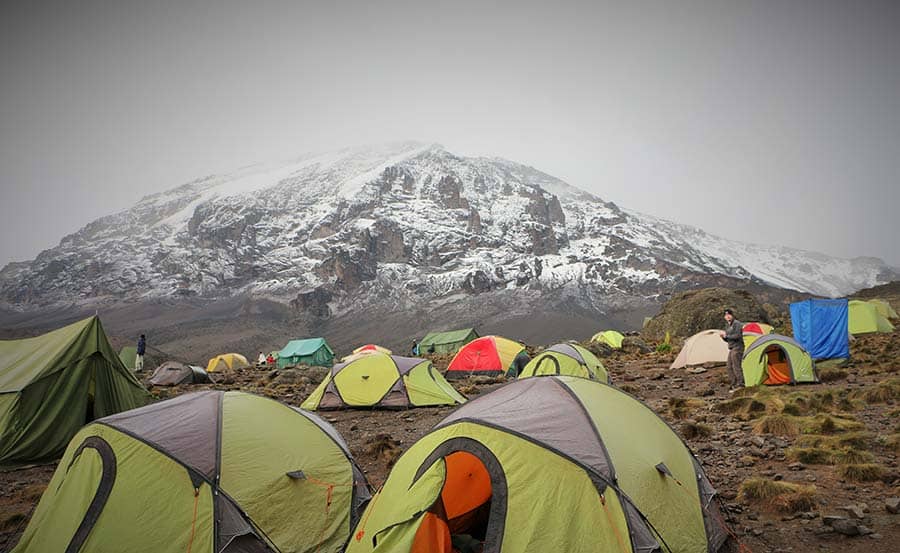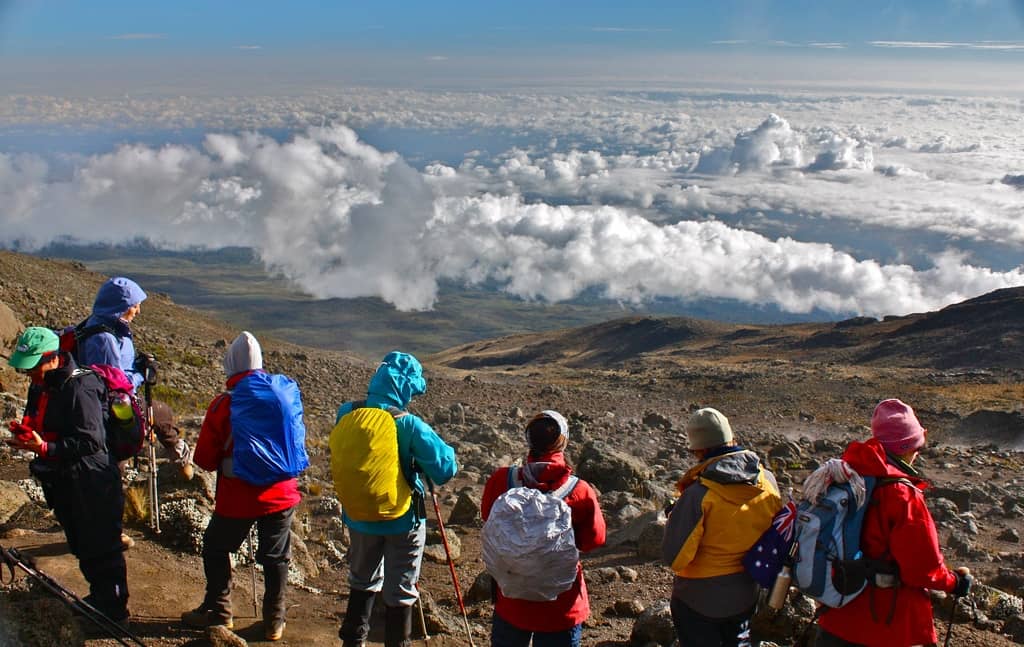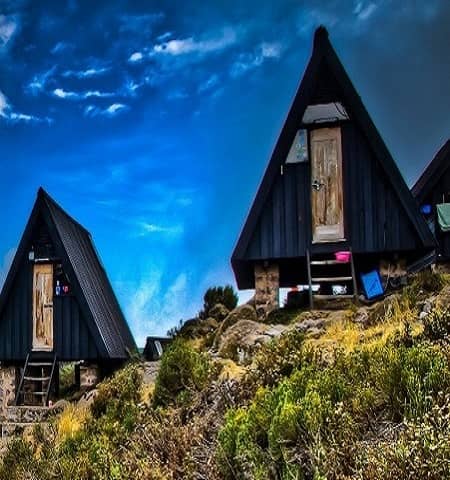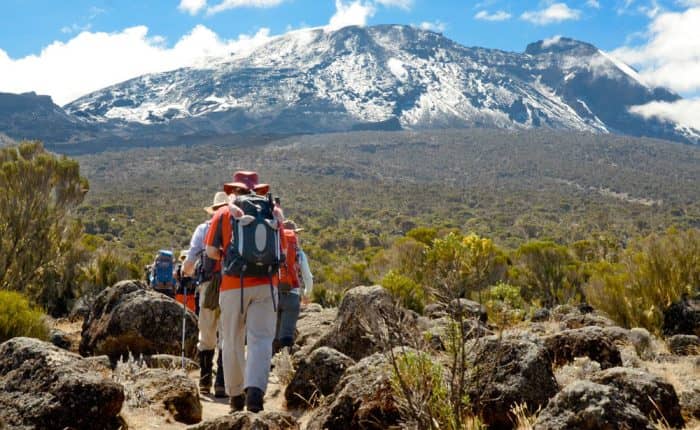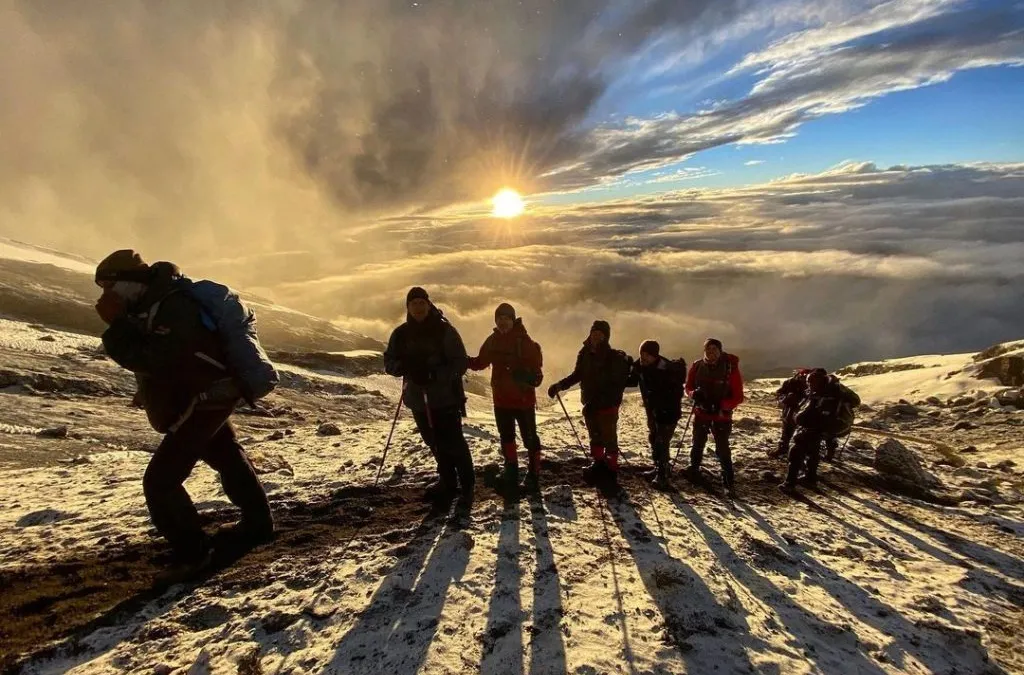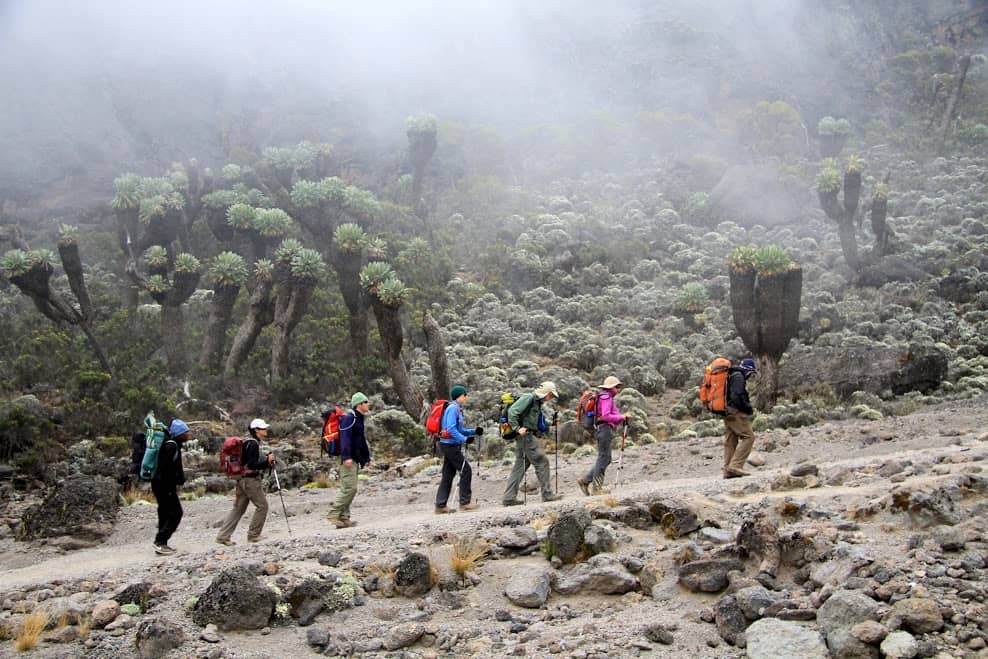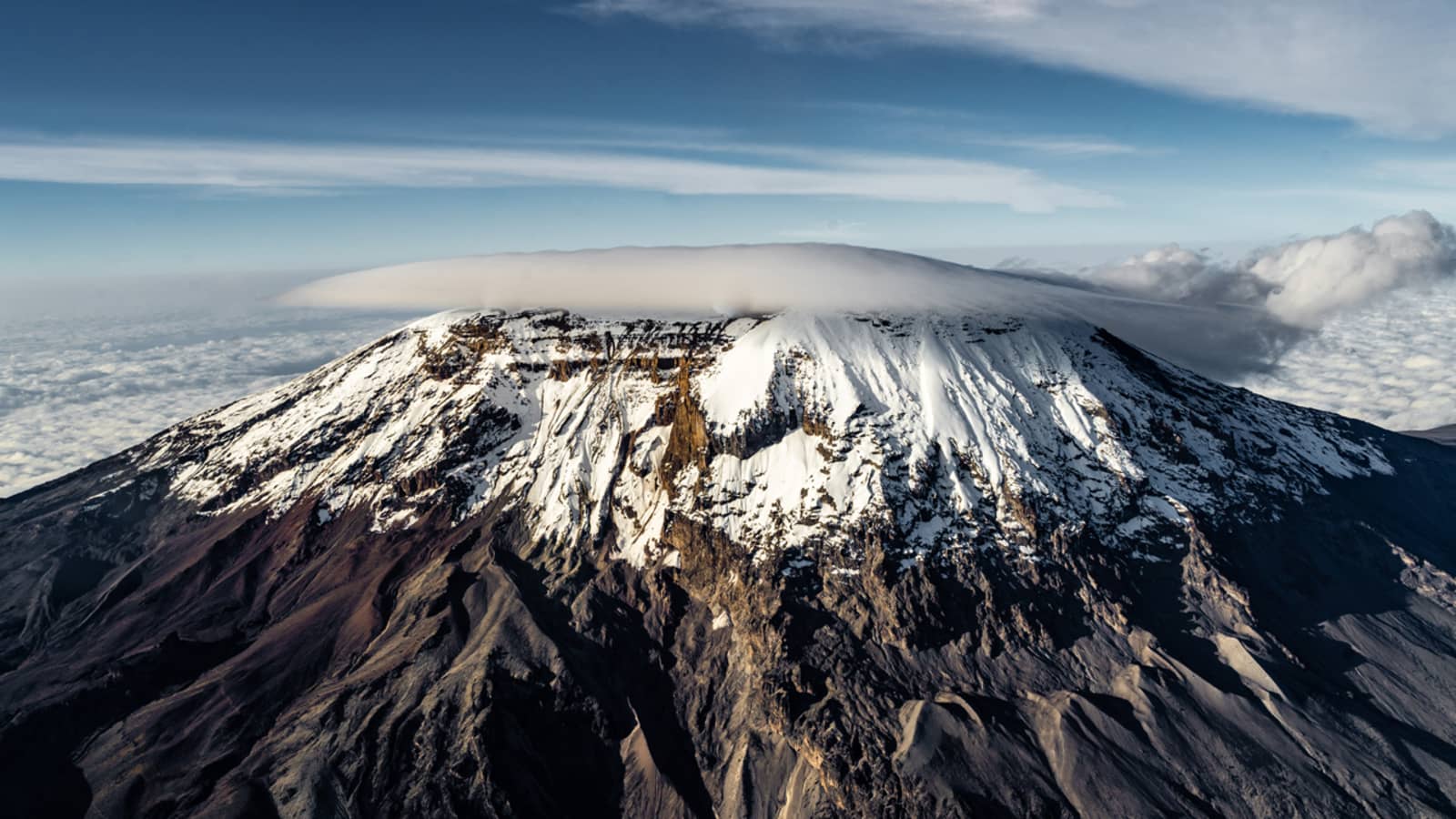KILIMANJARO FAQ's
KILIMANJARO FREQUENTLY ASKED QUESTIONS
THE- SUMMIT-ASCENT
MOUNT KILIMANJARO HEALTH-ISSUES
MOUNT KILIMANJARO PREPARATION
Start planning your Kilimanjaro hike
Hiking Kilimanjaro, the highest peak in Africa, is an incredible adventure, and a truly rewarding experience. However, it is essential to understand that this challenge comes with its own set of difficulties, which require serious preparations and dedication. While there are no technical climbing or mountaineering skills required to climb Kilimanjaro, the high altitude can be quite taxing and demanding, and can lead to altitude sickness in some climbers. It takes a lot of physical and mental strength, endurance, and a positive attitude to conquer this majestic mountain. Nonetheless, with the right level of fitness, mental determination, and proper guidance, anyone can undertake this adventure and achieve their goals, gaining valuable life lessons and unforgettable memories along the way. So, if you are ready to embark on this incredible journey, make sure to prepare well and remember that the rewards are worth all the effort!
Mount Kilimanjaro, located in Tanzania’s Kilimanjaro National Park, is a dormant volcano with three peaks: Shira, Kibo, and Mawenzi. The highest peak, Uhuru, stands at 5,895m or 19,341 feet, making Kilimanjaro the highest mountain in Africa and the tallest free-standing mountain in the world. Kilimanjaro is part of the Seven Summits, which includes the highest mountain on each continent, with Kilimanjaro representing Africa. Although rapid ascent of the mountain can be dangerous due to altitude sickness, the summit can be reached in 4-5 days through fast routes. Interesting fact: both Everest Base Camp’s—South and North—are below Kilimanjaro’s summit.
Discover the 7 official routes on Kilimanjaro with our pros and cons summary guide. The Lemosho is a favorite, with great acclimatization and high summit success rates, taking 7-8 days. The Machame is another beautiful choice, taking 6-7 days for better acclimatization and high success rates. The Marangu is popular for being shorter and cheaper with hut accommodation, but success rates are lower. Shira has become less popular with its high starting point, and Umbwe is not recommended due to poor acclimatization. The Western Breach is a technical approach with an unstable trail and rockfalls, also not recommended. Learn more about each route.
The best time to climb Kilimanjaro is from January to March and June to October. January to March is colder but less busy than June to October. April and May are rainy, so it’s not a good idea to climb during these months. June to October is the busiest as it’s the holiday period in Europe and North America. November is rainy, while December is very cold. If you want to climb in November, the North route is usually dry. It’s best to check our article on the best time to climb Kilimanjaro for more details.
Kilimanjaro’s weather is mostly affected by how the wind moves. When the Southeast rainy winds from the Indian Ocean reach Kilimanjaro (around March), they rise up and create rainy clouds. This happens until May. From April to October, the Northeast dry winds are strong enough to stop the Southeast rainy winds from coming up and keep Kilimanjaro dry. In November, light rains come to the north of Kilimanjaro, and the wettest months are March, April, and November. The best time for hiking is usually from January to March and from June to October because it’s warm and there is less rain. It’s usually cold and snowy from December to May.
The cost of hiking Kilimanjaro ranges from $2,000-$3,000 which is not cheap. Before 1991, anyone could go on the hike alone, but now, a registered guide and entrance park fees are required. The park fees have become more expensive and can be as much as $1,000 depending on the length of the trek. Nowadays, most hikers have a support team to ensure safety. A standard hike involves a guide, cook, and porters, making the hike cost an average of $2,000-$3,000, not including travel expenses. Some operators offer cheaper hikes for around $1,500, but their treatment of porters may be questionable.
If you’re traveling to Mount Kilimanjaro, you need to be aware of altitude sickness, which happens because the mountain is so high and you climb it quickly. It’s important to understand the risks, symptoms, and how to acclimate properly. We’ve made a detailed guide online about acclimating and avoiding altitude sickness, and we also tell you about two serious conditions called High Altitude Pulmonary Edema and Cerebral Edema. You can find the guide by clicking on the link, and we suggest that you also read our article about a medication called Diamox that can help prevent altitude sickness.
Did you know that Kilimanjaro is one of the most popular hiking destinations in the world? With its breathtaking views and challenging terrain, it attracts approximately 35,000 hikers each year. Whether you’re a seasoned hiker or just starting out, climbing Kilimanjaro is an adventure that’s sure to test your limits and leave you with unforgettable memories. From the lush rainforest at the base to the rugged, rocky summit, the trek offers a diverse range of landscapes that will keep you engaged and motivated throughout your journey. So why not join the thousands of adventurers who tackle Kilimanjaro each year and experience the thrill of a lifetime? With careful planning and preparation, you too can conquer Africa’s highest peak.
Climbing Kilimanjaro is easier if you take more time to trek it. The success rate of reaching the summit is higher if you take more days because your body has more time to get used to the altitude. Depending on the route you choose, the chance of success varies from 45% to over 85%. Tour operators we work with say that everyone who climbs Kilimanjaro or Mount Meru with them has a success rate of over 85%.
If you’re going to climb Kilimanjaro, you need good insurance. Normal travel insurance might not cover the risks of high altitude. Check out our article on Kilimanjaro Travel Insurance for advice on what kind of insurance you need. Or try using the quote calculator from our partner World Nomads, who specialize in coverage for hiking up to 6000m, which is perfect for Kilimanjaro.
The equipment list for climbing Kilimanjaro is very important. Some items can be rented or bought in Moshi or Arusha before your trek. However, it is recommended to bring very important gear with you to Kilimanjaro. You can find a detailed list of recommended gear and where to buy or rent. The list includes clothing, headwear, footwear, gloves and trekking poles, bags, sleeping bags, and other accessories. The weather on Kilimanjaro can change quickly and drastically, so it is important to have the right gear and clothes for the different altitudes. The list is divided into different sections, making it easy to find what you need. Don’t forget to bring water bottles and zip-lock bags, among other things. It is recommended to look for sleeping bags with specific characteristics suitable for Kilimanjaro. This list has everything you need to have a successful climb!
If you are planning to climb Kilimanjaro, it is essential that you make sure that you are adequately prepared for the trekking adventure ahead. While it can be tempting to jump right into the climb, it is recommended that you engage in adequate training before commencing your adventure. Experts suggest that a training period of 6 to 8 weeks should be sufficient to get your body in shape and ready to tackle the rigors of climbing Kilimanjaro.
Now, what is the best type of training for trekking Kilimanjaro? Well, there is no one-size-fits-all answer to this question, as it largely depends on your fitness level and what kind of access you have to the outdoors. However, long-distance mountain trail walking is generally recommended as the most beneficial form of training for Kilimanjaro trekking. On the other hand, if you don’t have access to mountainous terrain, you can still prepare yourself by engaging in some aerobic gym workouts such as running, cross-training, swimming, and strength training such as leg workouts. By engaging in a rigorous training program, you can be sure that you are physically fit and adequately prepared to tackle Kilimanjaro.
Check out our Kilimanjaro library for great books and guidebooks on the mountain. For a comprehensive and informative guide, get Kilimanjaro: The Trekking Guide to Africa’s Highest Mountain by Henry Stedman. If you want an affordable option, Mount Kilimanjaro: Trekkers Guide to the Summit by our lead editor has all the essential information. For fun fiction, read The Shadow of Kilimanjaro by Rick Ridgeway or Zombies on Kilimanjaro by Tim Ward.
It can be a difficult and risky journey for hikers to summit Mount Kilimanjaro. The environment poses various dangers to those who partake in the climb, leading to the estimation that between 3-10 people die each year while hiking. These deaths can be due to a number of different reasons, including the onset of altitude sickness (such as High Altitude Cerebral Edema and High Altitude Pulmonary Edema), falls, and hypothermia. Additionally, porters who assist with carrying equipment and supplies may also experience a tragic fate due to the onset of malaria while on the trek.
While this information can be concerning and alarming, it’s important to note that official statistics on deaths from KINAPA are not provided, which is why there may be conflicting numbers shared online. It’s always best to use caution and take necessary precautions when preparing for a climb like this.
Climate change is affecting Kilimanjaro’s glaciers as they have been rapidly receding for the past century. Human-induced climate is largely to blame. Kilimanjaro has lost 82% of its ice cap since 1912, and since 1962, it has lost 55% of its remaining glaciers. If the present rate of receding continues, most of the glaciers on Kilimanjaro could disappear.
THE- SUMMIT-ASCENT
Introduction
Your summit attempt is really the big day. You will finally know whether you will walk on the roof of Africa, or at least be able to say that you tried. Of course, you want to make it to the summit.
Your summit attempt is really the big day. You will finally know whether you will walk on the roof of Africa, or at least be able to say that you tried. Of course, you want to make it to the summit. Here are a few things that you can do to give you the best chances of making the summit on your first attempt.
Even though you will be starting very early you must make the most of the time you have in base camp and get as much sleep as you can. If you’ve been eating and drinking properly, you’ll probably be up a few times during the night as it is.
It is nearly impossible to eat or drink too much at this stage. Summit day will be a 14 to 15-hour trek, and it will not be easy going. You can expect to burn more than 4000 calories on summit day alone, so eat well. You’ll be hiking for some 15 hours, virtually non-stop. Bring snacks and a lot of them! Remember to put some of them in your pockets, preferably in warm places, that you have easy access to so that you can nibble while you walk without having to stop every time to get something out of your rucksack. Bring what you like best, but we have found that some of the best options are candy bars/chocolate, cookies/biscuits, crisps, energy bars, hard candy/boiled sweets, nuts/dried fruit, and trail mix. Nuts are great at altitude as they don’t freeze, whereas energy and candy bars, particularly chocolate ones, tend to freeze about 5000 meters, and drink at least twice as much water as you think you should even when you are not thirsty or hungry.
The risks of dehydration are very high at altitude and they also mirror the symptoms of AMS, so our mantra is to drink a minimum of 3 liters every single day of the climb to keep you fully hydrated. These fluids can be made up of hot drinks with your meals plus a minimum of 2 liters fluid whilst you are actually trekking. Sounds easy doesn’t it, but you need to be self-disciplined and self-aware to actually do it when you are tired and think you are not thirsty.
Also, for summit night you will need to carry water in a wide mouthed Nalgene bottle as above 5000 meters everything freezes! You may be surprised to learn that water freezes from the top down, so firstly insulate your Nalgene bottle by stuffing it inside a spare pair of socks and then pack it upside down in your rucksack. If you are using a platypus then make sure that the pipe is insulated or keep it tucked inside your clothes and jacket and just pull the mouthpiece out when you need to take a drink, then blow the water back down the tube before you put the mouthpiece back. Platypus users will also need to carry a liter of fluid in a wide-mouthed Nalgene bottle as a precautionary measure.
We cannot stress enough. The attempt on the summit is exhausting, and you have to fuel the climb if you expect to make it. Eat like a 5-year-old at Christmas and enjoy all those extra calories!
Making sure you are neither too hot nor too cold will conserve your energy for when you really need it. You should be slightly cooler than is comfortable when you first set off. ‘Be bold, start cold’ as we say. We advise you to remove your over jacket or down jacket when you set off, then immediately put it back on when you make a ‘maintenance stop’. This will keep you more comfortable, and make sure you aren’t expending energy sweating that you could be used to climb to the summit!
During the attempt on the summit, we will have quite a few short ‘maintenance stops’. These do not rest stops, and you shouldn’t rest. Plan what you will need to do at your next stop while you hike. At the very least, you will need to put on something warm as soon as you stop, have something to eat and drink, and make sure your kit is in good order. If you have been drinking as much as you should be, you will probably need the loo, as well.
Our guides will set a pace that takes the needs of your entire group into account, and you should try to maintain it if at all possible. Try to go too fast and you will put yourself at extra risk of altitude sickness. Going too slow will mean that you have little time for anything but hiking and sleeping. Just keep plodding along with your guide, and you will get there at just the right time.
MOUNT KILIMANJARO HEALTH-ISSUES
Introduction
Your summit attempt is really the big day. You will finally know whether you will walk on the roof of Africa, or at least be able to say that you tried. Of course, you want to make it to the summit.
Please note Each client that books with ‘Outstanding Tanzania Safari‘receives a comprehensive 2-page health guide that addresses all the health issues related to climbing Kilimanjaro.
Acute Mountain Sickness is also referred to as “Altitude Sickness”, and as the name indicates the illness is commonly encountered at exceptionally high altitudes, such as the summit area of Mount Kilimanjaro. AMS, once apparent, can be most effectively treated by immediately taking the affected person to a lower altitude. Often a drop as little as 500m will be sufficient. The symptoms of AMS include in the order normally experienced; headaches, nausea, anorexia, exhaustion, lassitude, rapid pulse, insomnia, swelling of the hands and feet and reduced urine output. Climbers can take precautions to at least minimize the severity of the illness, by maintaining a slow steady pace from day one, including an extra day of acclimatization at a high altitude and by drinking at least 3-4 liters of water every day. Preventative medicine is also available and you should consult your physician for specialist advice. Fluid build-up may cause a condition known as edema (or edema), which can affect the lungs (pulmonary), preventing effective oxygen exchange, or affect the brain (cerebral) which will result in the swelling of the brain tissue. The latter can be lethal if not treated immediately or if symptoms are ignored. Probably 70% of all people climbing Kilimanjaro will suffer to some extent from AMS. You should familiarise yourself with this condition and take preventative care.
Hypothermia or exposure is the lowering of the body’s core temperature. Once again prevention is the best cause of action. The correct equipment and clothing are critical in the prevention of Hypothermia. Do not allow your clothing to get wet from either rain or perspiration.
The treatment of hypothermia is relatively simple. Get the victim into a sheltered area as quickly as possible, remove all wet clothing and place the victim inside two or three sleeping bags, preferably with another person to help heat the victim.
About 55% of the earth’s protective atmosphere is below an altitude of 5000m. Far less ultraviolet light is being filtered out, making the sun’s rays much more powerful, which could result in severe sun burning of the skin. It is strongly recommended to use a 20+ sun protection cream at lower altitudes, and a total block cream above an altitude of 3000m. It is also important to wear dark sunglasses preferably with side panels above 4000m in the daytime and essential when walking through snow or ice. Snow blindness can be very painful and will require your eyes to be bandaged for at least 24 hours.
Any climber who suffers from any cardiac or pulmonary problems should be cautious and should not attempt to climb the mountain unless they have consulted their physician. It is strongly recommended that a physical fitness program is followed to prepare yourself physically for the mountain.
Poor fitting, new or little used boots will result in blistering feet. Even if boots are only slightly too small, your toes will get bruised, particularly on you descend. It is it therefore also important to keep your toenails short for the climb. Developing blister should be treated immediately as soon as the “hot spot” is felt. Remove the boot and cover the area with a zinc oxide tape or something similar.
MOUNT KILIMANJARO PREPARATION
Introduction
KILIMANJARO SUMMIT PREPARATION Achieving a reasonable degree of physical fitness should be a goal in your preparation.
Achieving a reasonable degree of physical fitness should be a goal in your preparation. Being in good shape will increase your chances of having a safe climb, successful summit, and enjoyable experience.
Achieving a reasonable degree of physical fitness should be a goal in your preparation.
Being in good shape will increase your chances of having a safe climb, successful summit, and enjoyable experience.
Climbing Kilimanjaro does not take any technical mountaineering skills. It is a trek at high altitude, and nearly anyone in decent physical condition can climb Mount Kilimanjaro. However, one should not underestimate the effort required over six to nine days to reach the peak.
The main reason that climbers fail to reach the summit is due to the inability to acclimatize to the high altitude quickly enough. Short of going to high altitude, there is little that one can do to pre-acclimatize before the climb. Being physically fit does not guarantee that climbers can overcome altitude issues, but it does reduce the strenuousness of the climb on the body, which in turn, makes acclimatization more likely.
Ideally, your training should simulate actual conditions encountered on Kilimanjaro.
Performing day hikes on local trails are the recommended form of training. The trails should include uphill and downhill sections, and you should wear the clothing, boots, and pack that you intend to climb in. Try to hike for several hours. Your hikes on the mountain will on average be between four to six hours but can be as little as two (easy days) and as high as 14 hours (summit day). If it is impractical for you to train outdoors, you may exercise at the local gym. The staple of your training should be walking on a Stairmaster, supplemented with weight-training for your legs.
A minimum of three days a week, perhaps shorter sessions during the weekdays and longer sessions on the weekends, for three months, is suggested. With proper training, you will develop the leg strength, endurance, and confidence necessary for Kilimanjaro.
Our trips begin in Arusha, Tanzania, Clients should fly into Kilimanjaro International Airport (airport code: JRO) and we make the way to the designated hotel in Arusha.
Watching the sunrise on top of Mount Kilimanjaro is a highlight – literally. The adventure of climbing Kilimanjaro, the Roof of Africa, is an experience you will carry for the rest of your life. It is the tallest free-standing mountain but the highly accessible summit attracts amateur and professional climbers from all over the world. With preparation, focus, and motivation you can beat any mental or physical barrier to reach Uhuru Peak at 5895m/19341ft. It is the ultimate adventure in Africa, part of the world’s 7 summits, and extremely rewarding when you reach the top and feel the sense of accomplishment at Uhuru Peak.
Safety comes first when climbing any mountain. Therefore, your experience, personal physiology, and health condition must be considered in the choice of route and number of days. In general, spending more days for acclimatizing lets you enjoy more and increase the probability of success. Our gear list is also provided in the program we create for you together with additional useful information, to help you prepare a successful expedition with safety and quality of experience.
Our Kilimanjaro Head and Assistant guides are licensed and professionally trained to take you safely to Uhuru peak, and back. Our Head guides have experience of 50-100+ successful summits and work with a handpicked crew of experienced Assistant guides, Cooks, and Porters. Their strong, genuine and friendly characters combined with their passion for Kilimanjaro contribute to the quality of experience, link to Kilimanjaro culture and provide that extra motivation, when needed during the expedition, to reach the summit and come back safely.
Kilimanjaro porters are the heart and soul of the mountain. There are few experiences as humbling as being passed by porters on a climb. They carry food, water, and equipment to ensure a comfortable climb and increased summit success rate. They are certainly among the hardest working men in Tanzania and we make sure they are rewarded properly for their efforts. Outstanding Tanzania Safari porters receives $18/person/day, which is the highest salary levels and un-preceded in the history of Kilimanjaro expeditions. We are proud of this fact and know that this is a fair amount, agreed upon by our staff, for the hard work done!
Marangu, Machame, Lemosho, Rongai, Shira, and Umbwe are the routes we choose from depending on your preferences, time and experience. We highly recommend Machame route for 7 days or Lemosho route for 8-9 days. Both routes allow great acclimatizing opportunities, highest chances of summit success and varied scenery of the mountain each day boosting motivation.
Safari Tour Specialists35+
We have many experts that have been in hospitality industry for long and who can deliver full satisfaction to trevellers
Years of experience12
We have been here for long and we understand well what our clients needs. An adventurous journey with us.
Safe traveling98%
Our guides a fully vaccinated and take full precaution on all rules that are stipulated under the safety rules.

